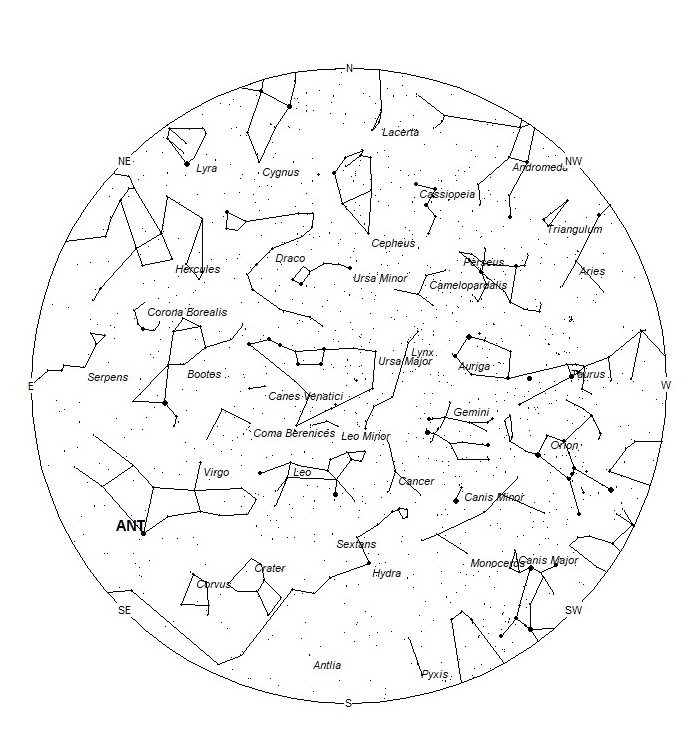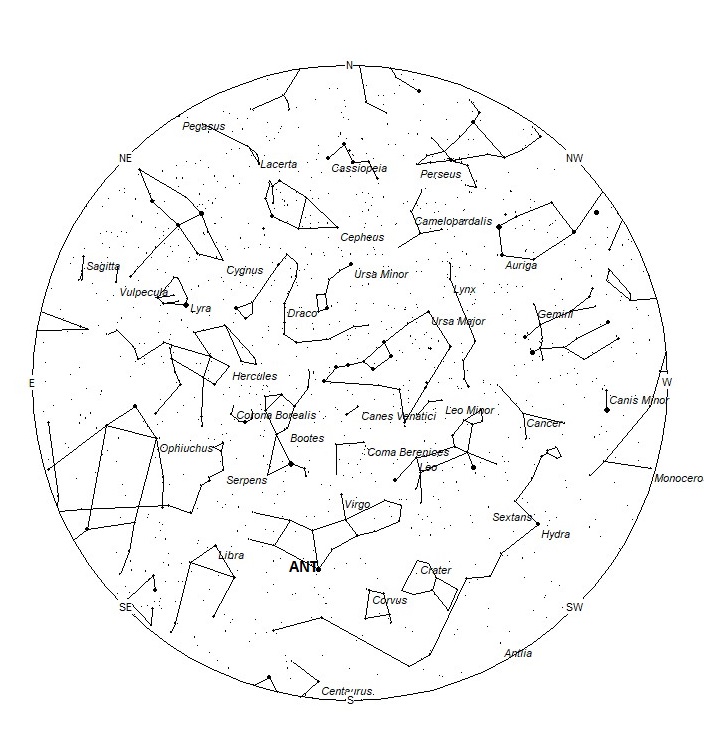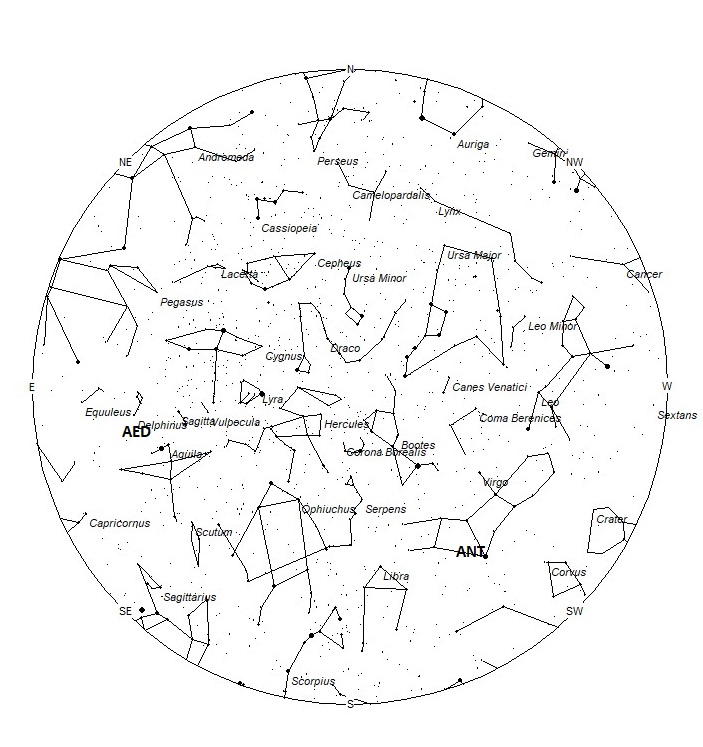Meteor activity picks up a bit during April as the Lyrids become active during the month. They are active from the 15th through the 29th, with a pronounced maximum on the 22nd. Sporadic rates during April are steady as seen from both hemispheres with southern observers enjoying more activity that can be seen from the mid-northern hemisphere. The eta Aquariids will become active the second half of the month, adding a few swift meteors to the late morning scene.
During this period the moon reaches its last quarter phase on Sunday April 4th. On this date the moon is located 90 degrees west of the sun and rises near 3:00 local summer time (LST). As the week progresses the moon will rise later each night, providing a growing window of opportunity to view under dark skies between dusk and moonrise. The estimated total hourly meteor rates for evening observers this week is near 2 as seen from mid-northern latitudes and 3 as seen from tropical southern locations (25S). For morning observers, the estimated total hourly rates should be near 7 as seen from mid-northern latitudes (45N) and 10 as seen from tropical southern locations (25S). Morning rates are reduced due to moonlight during this period. The actual rates will also depend on factors such as personal light and motion perception, local weather conditions, alertness, and experience in watching meteor activity. Note that the hourly rates listed below are estimates as viewed from dark sky sites away from urban light sources. Observers viewing from urban areas will see less activity as only the brighter meteors will be visible from such locations.
The radiant (the area of the sky where meteors appear to shoot from) positions and rates listed below are exact for Saturday night/Sunday morning April 3/4. These positions do not change greatly day to day so the listed coordinates may be used during this entire period. Most star atlases (available at science stores and planetariums) will provide maps with grid lines of the celestial coordinates so that you may find out exactly where these positions are located in the sky. A planisphere or computer planetarium program is also useful in showing the sky at any time of night on any date of the year. Activity from each radiant is best seen when it is positioned highest in the sky, either due north or south along the meridian, depending on your latitude. It must be remembered that meteor activity is rarely seen at the radiant position. Rather they shoot outwards from the radiant, so it is best to center your field of view so that the radiant lies at the edge and not the center. Viewing there will allow you to easily trace the path of each meteor back to the radiant (if it is a shower member) or in another direction if it is sporadic. Meteor activity is not seen from radiants that are located far below the horizon. The positions below are listed in a west to east manner in order of right ascension (celestial longitude). The positions listed first are located further west therefore are accessible earlier in the night while those listed further down the list rise later in the night.
These sources of meteoric activity are expected to be active this week.
.
The center of the large Anthelion (ANT) radiant is currently located at 13:48 (207) -12. This position lies in eastern Virgo, 4 degrees east of the 1st magnitude star known as Spica (alpha Virginis). Due to the large size of this radiant, Anthelion activity may also appear from Libra as well as eastern Virgo. This radiant is best placed near 0200 LST, when it lies on the meridian and is located highest in the sky. Rates at this time should be near 2 per hour no matter your location. With an entry velocity of 30 km/sec., the average Anthelion meteor would be of slow velocity.
The April epsilon Delphinids (AED) were discovered by P. Jenniskens and R. Rudawska from CAMS and SonotaCo meteoroid orbit surveys published in 2014.This weak source is active from April 4-20, with maximum activity occurring on the 9th. The radiant currently lies at 20:13 (303) +09. This position lies on the Delphius/Aquila border, 5 degrees east of the 1st magnitude star known as Altair (alpha Aquilae). With an entry velocity of 61km/sec., the average meteor from this source would be of fast velocity. These meteors are best seen during the last dark hour prior to morning twilight. Current hourly rates would be less than 1.
The delta Pavonids (DPA) were discovered by Michael Buhagiar from Australia in the 1970’s. These meteors are active from March 11 through April 16, with maximum activity occurring on March 30th. The current position of the radiant lies near 20:58 (314) -64. This area of the sky lies in eastern Pavo, 2 degrees northeast of the 3rd magnitude star known as beta Pavonis. These meteors are best seen during the last dark hour prior to dawn. With an entry velocity of 58km/sec., the average meteor from this source would be of fast velocity. Expected rates are less than 1 per hour during this period.
As seen from the mid-northern hemisphere (45N) one would expect to see approximately 5 sporadic meteors per hour during the last hour before dawn as seen from rural observing sites. Evening rates would be near 1 per hour. As seen from the tropical southern latitudes (25S), morning rates would be near 8 per hour as seen from rural observing sites and 3 per hour during the evening hours. Locations between these two extremes would see activity between the listed figures. Morning rates are reduced during this period due to moonlight.
The list below offers the information from above in tabular form. Rates and positions are exact for Saturday night/Sunday morning except where noted in the shower descriptions.
| SHOWER | DATE OF MAXIMUM ACTIVITY | CELESTIAL POSITION | ENTRY VELOCITY | CULMINATION | HOURLY RATE | CLASS |
| RA (RA in Deg.) DEC | Km/Sec | Local Summer Time | North-South | |||
| Anthelion (ANT) | – | 13:48 (207) -12 | 30 | 02:00 | 2 – 2 | II |
| April epsilon Delphinids (AED) | Apr 09 | 20:13 (303) +09 | 61 | 08:00 | <1 – <1 | IV |
| delta Pavonids (DPA) | Mar 30 | 20:58 (314) -64 | 58 | 09:00 | <1 – <1 | IV |




